12 Best Workflow Automation Software Picks for 2025
Discover the 12 best workflow automation software tools to boost productivity. Our guide covers features, pricing, and real-world use cases.

That constant switching between apps? The copy-pasting, the manual data entry, the endless small tasks that pull you out of deep work? That's not just annoying; it's a productivity killer. Repetitive busywork drains your creative energy and keeps you from focusing on what actually matters. Workflow automation isn't some complex, enterprise-level luxury anymore. It’s a crucial toolkit for solopreneurs, freelancers, and small teams looking to reclaim their time and sanity.
The game has changed significantly with the rise of accessible AI, especially for text-based tasks. Imagine your AI assistant not just living in another tab, but working directly within your documents, emails, and social media posts. The key to meaningful productivity gains is integrating AI where the work happens. This guide is your map to finding the best workflow automation software to make that a reality. We're cutting through the noise to give you a curated breakdown of top-tier tools, from powerful, multi-app integrators to specialized AI assistants that polish your writing everywhere you work. To truly appreciate the power of these tools, considering various business process automation examples can illuminate their real-world impact.
In this list, you'll find a detailed look at each platform, complete with screenshots, honest pros and cons, and practical use cases designed for creators and marketers. We'll show you how to connect your favorite apps, automate mundane processes, and integrate AI into your daily writing to improve speed and quality. No fluff, no marketing jargon, just a straightforward resource to help you choose the right tool to stop drowning in busywork and start working smarter.
1. TypeBoost
Best for: System-Wide AI Writing & Editing on macOS
TypeBoost emerges as a standout choice for anyone seeking to embed AI-powered text generation and editing directly into their existing macOS workflow. Instead of treating AI as a separate destination you have to visit, TypeBoost acts as an omnipresent assistant, available in any application via a simple keyboard shortcut. This fundamental design shift makes it one of the best workflow automation software options for writers, marketers, and professionals who want to enhance their text without breaking their creative momentum. It eliminates the constant, tedious cycle of copying text, switching to a browser, pasting into an AI tool, and then copying the result back.
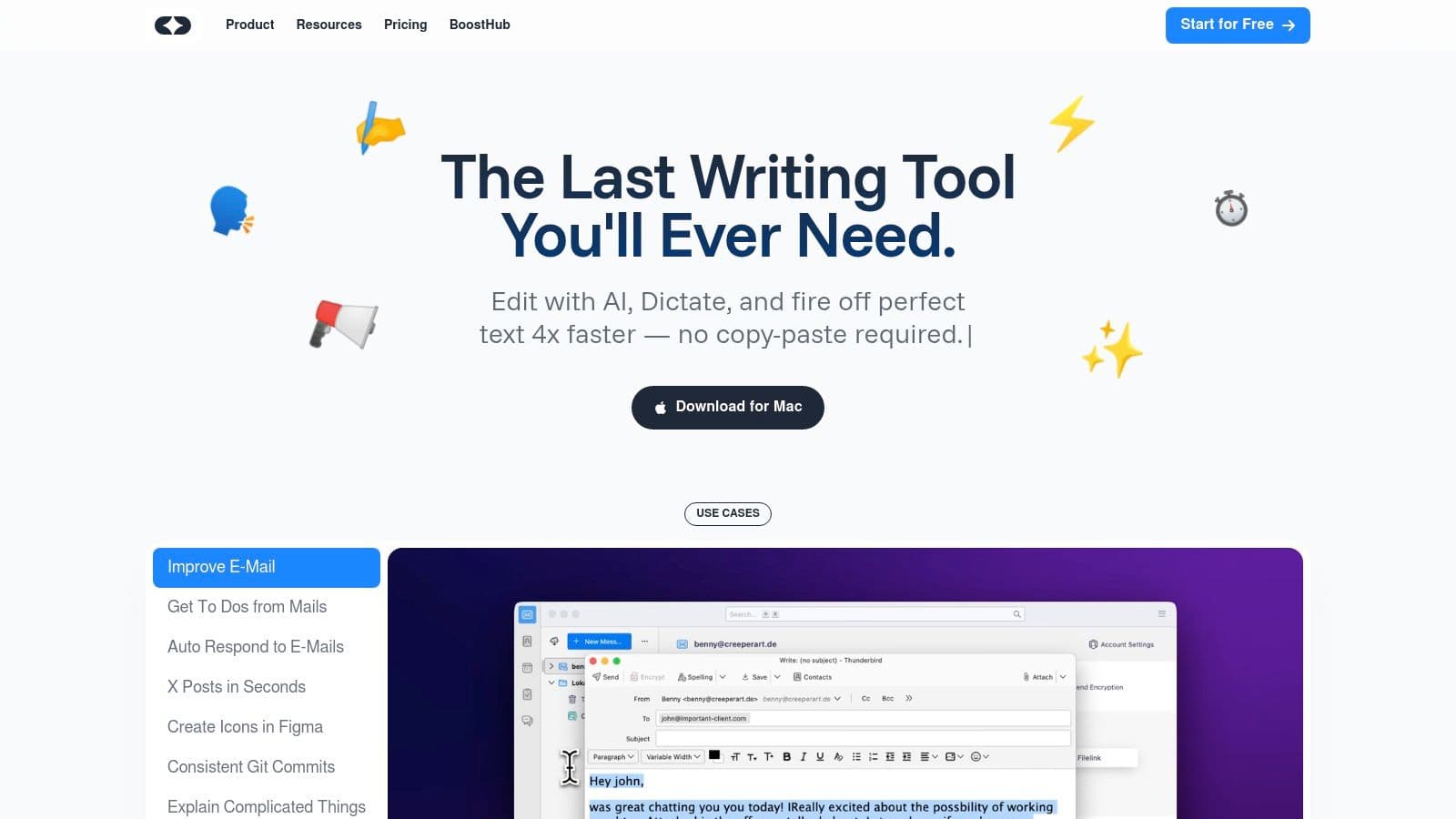
Its core strength lies in its keyboard-first, in-place editing. Whether you're drafting a client email in Gmail, brainstorming in Notion, or posting on LinkedIn, you can highlight text, press a shortcut, and instantly apply an AI command. This could be anything from fixing grammar and improving clarity to summarizing a long document or changing the tone to be more professional. This immediate, contextual assistance is a massive productivity gain.
Standout Features & Use Cases
TypeBoost is more than just a proofreader; it's a versatile content creation engine. Here’s how you can leverage its key features for meaningful productivity gains:
- Custom Prompt Library: The true power of text-based AI comes from personalization. Don't just rely on generic "improve this" commands. Create and save your own custom "Boosts" for recurring tasks. For example, you could create a prompt that rewrites technical jargon into simple, client-friendly language or one that formats your raw notes into a perfect LinkedIn post structure. This turns the tool into an extension of your own voice and style.
- Dual Mode - Voice & Text: A unique feature is the ability to combine text selection with voice commands. Highlight a paragraph and simply say, "Rewrite this to sound more confident and add a call to action." This is incredibly efficient for quick edits and feels more natural than typing out every instruction.
- BoostHub Community: Explore the BoostHub library to discover pre-made prompts tailored for specific tasks, from crafting compelling ad copy to generating creative story ideas. It’s an excellent way to learn new AI prompting techniques and expand your creative toolkit.
Pricing & Availability
TypeBoost offers a flexible pricing structure, making it accessible for various usage levels.
- Free Plan: Includes a generous trial with no credit card required.
- Starter Plan: €5/month for more characters, voice minutes, and custom prompts.
- Pro Plan: €12/month for heavy users needing extensive capacity.
The primary limitation is its exclusivity to the macOS ecosystem, which means Windows and mobile users currently cannot access it.
| Pros | Cons |
|---|---|
| Seamless, system-wide integration across all macOS apps. | Only available for macOS. |
| Powerful keyboard-first design keeps you in your workflow. | Voice and character limits are tied to subscription tiers. |
| Fully customizable prompt library and a community marketplace. | |
| Generous free plan and affordable paid tiers. |
Visit TypeBoost
2. Zapier
When it comes to connecting your digital toolkit, Zapier is the undisputed heavyweight champion. It’s the glue of the internet for a reason. With a staggering library of over 6,000 app integrations, it’s one of the best workflow automation software options for anyone who wants to link their favorite apps without writing a single line of code. Think of it as a universal translator for your software, allowing tools that don't natively speak to each other to communicate seamlessly.
The platform is built around "Zaps," which are simple "if this, then that" workflows. For example, if you get a new lead in a Facebook Lead Ad, a Zap can automatically add that contact to a Mailchimp list and create a new row in a Google Sheet. It’s incredibly intuitive for non-technical users.
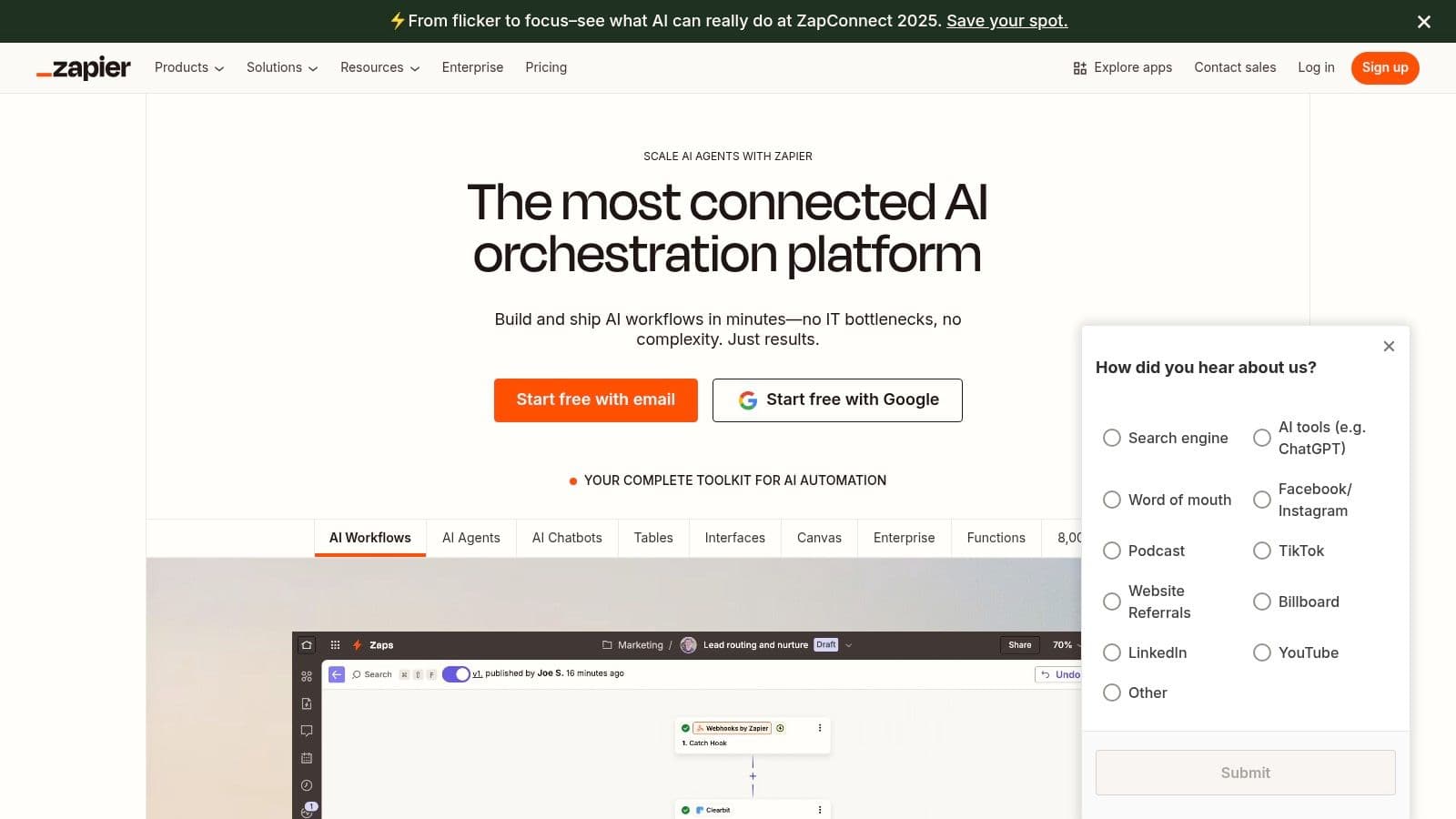
Why Zapier Stands Out
Zapier's biggest advantage is its sheer scale and simplicity. The visual workflow builder makes it easy to visualize how your data moves, and you can add conditional logic (called Paths) to create more sophisticated automations. For instance, you could route inbound support tickets to different Slack channels based on keywords in the email subject. A meaningful productivity tip is to use its built-in AI tools. You can create a Zap that triggers whenever a new blog post is published, uses AI to generate three social media post variations, and then saves them as drafts in your scheduling tool. This automates the creative, text-heavy lifting of content promotion.
Pricing, Pros & Cons
| Aspect | Details |
|---|---|
| Pricing | Starts with a Free plan for 100 tasks/month. Paid plans (Team, Company) start at $19.99/month, increasing tasks and adding premium features like multi-step Zaps. |
| Pros | Massive Integration Library: If an app exists, it probably connects to Zapier. User-Friendly: Extremely low learning curve; you can build your first Zap in minutes. Flexible: Pay-per-task overages prevent your critical workflows from shutting down if you exceed your plan's limit. |
| Cons | Cost at Scale: The task-based pricing can become expensive for high-volume operations. Less Enterprise Control: Lacks the deep governance and error-handling features found in enterprise-grade iPaaS solutions. |
Website: zapier.com
3. Make (formerly Integromat)
For those who want to move beyond simple "if this, then that" logic, Make (formerly Integromat) offers a powerful and visually engaging canvas. It’s one of the best workflow automation software choices for users who need more granular control over their data flow. Instead of linear steps, Make uses "scenarios," where you can visually drag and drop modules, create complex branches with routers, and iterate over data bundles. It feels less like connecting a-to-b and more like building a true data processing machine.
This modular approach lets you construct sophisticated multi-step automations, such as parsing an email attachment, transforming the data, and then updating records across multiple CRMs and project management tools, all within a single, elegant workflow. Its visual nature makes even the most complex processes understandable at a glance.

Why Make Stands Out
Make's key differentiator is its unparalleled flexibility and visual power. The drag-and-drop interface lets you add "routers" to split a workflow into multiple paths or use "aggregators" to merge data back together. For productivity, leverage its AI integration for text analysis. For example, build a scenario that watches a customer feedback form, sends the text to an AI module to determine if the sentiment is positive or negative, and then routes the feedback to either a "Testimonials" spreadsheet or a "Needs Follow-Up" task list. This provides immediate, meaningful data sorting. If you're looking to build more advanced systems, you can learn more about how AI workflow automation tools are changing the game and see how Make fits into that ecosystem.
Pricing, Pros & Cons
| Aspect | Details |
|---|---|
| Pricing | Includes a generous Free plan with 1,000 operations/month. Paid plans (Core, Pro, Teams) start at $9/month, offering more operations and features like full-text execution log search. |
| Pros | Powerful Visual Builder: The canvas-style interface allows for complex branching, filtering, and error handling. Cost-Effective: Offers a high number of operations for its price, providing great value. Granular Control: Provides detailed control over data mapping and scheduling, down to one-minute intervals. |
| Cons | Steeper Learning Curve: The added complexity can be intimidating for absolute beginners. Operation-Based Pricing: Complex scenarios can consume operations quickly, requiring careful workflow design to manage costs. |
Website: make.com
4. n8n
For those who want more power under the hood and prefer an open-source approach, n8n is a standout choice. It positions itself as a developer-friendly platform that offers both a visual workflow builder and the ability to self-host, giving you complete control over your data and costs. This makes it one of the best workflow automation software options for technical teams or anyone looking to escape the per-task pricing models that can get expensive at scale.
n8n is built on a "fair-code" model, meaning its core is visible and extensible, fostering a strong community of builders. You can run it on your own servers for maximum privacy or use their managed cloud service. The platform uses a node-based editor where each step in your workflow is a highly configurable block, allowing for complex data transformations and custom logic.
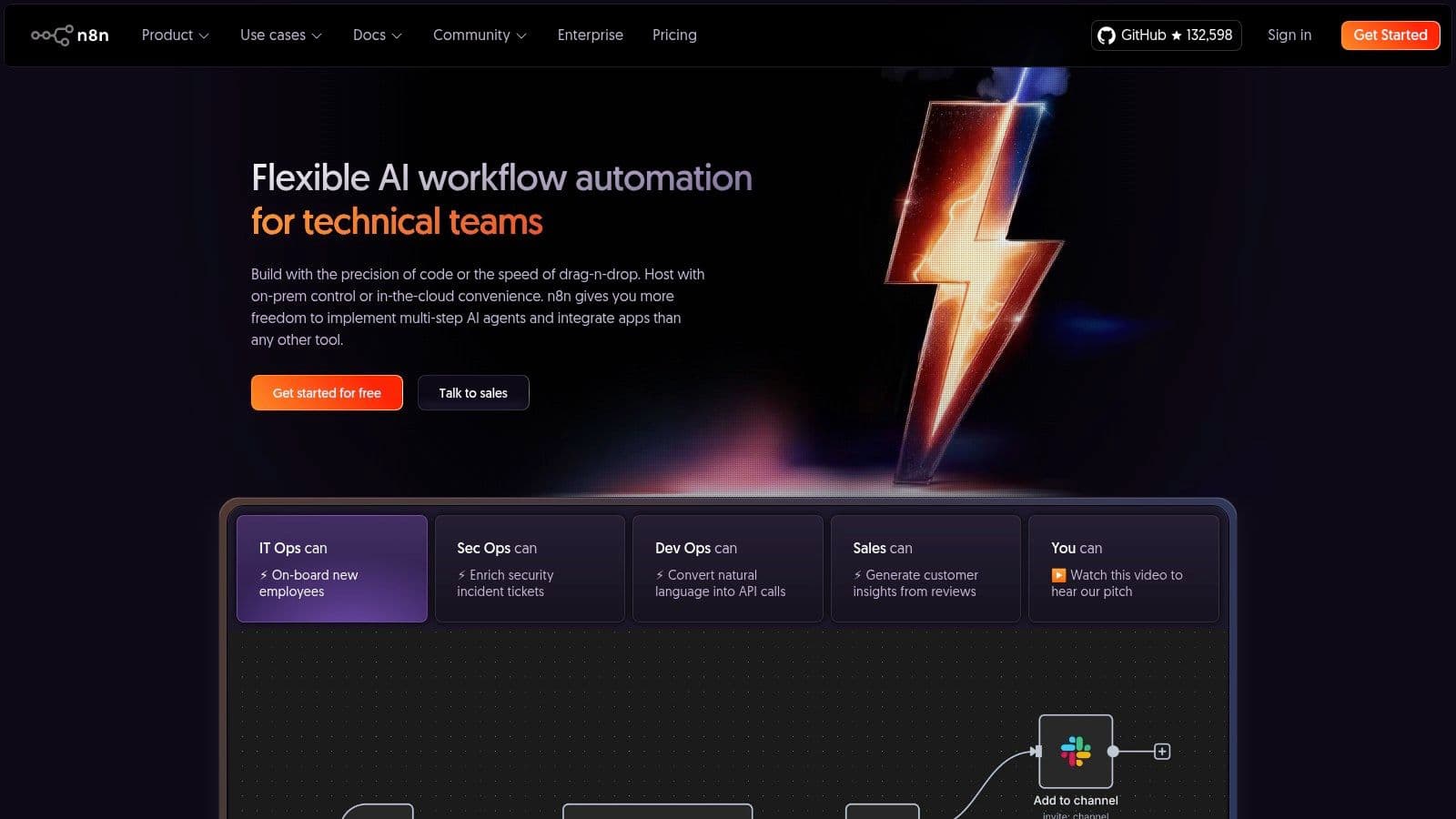
Why n8n Stands Out
n8n’s primary advantage is its flexibility and cost-effectiveness. The ability to self-host means you only pay for your server resources, not every single workflow execution. For developers, the platform is a dream, with JavaScript code nodes that let you write custom functions and the power to build your own connectors. A practical tip for text-based AI is to use its HTTP Request node to connect to any AI API (like OpenAI or Anthropic). You can build a custom workflow that pulls data from a source, sends it to the AI for summarization or reformatting, and then pushes the result to your preferred destination, giving you complete control over your AI-powered text tasks.
Pricing, Pros & Cons
| Aspect | Details |
|---|---|
| Pricing | Offers a Free self-hosted Community Edition. Cloud plans start at $20/month, priced by workflow executions rather than tasks. Business and Enterprise plans add governance features. |
| Pros | Cost-Efficient at Scale: Self-hosting can dramatically reduce costs for high-volume automation. Highly Extensible: Developers can use code nodes and build custom connectors. Data Control: Self-hosting provides full data privacy and sovereignty. |
| Cons | Requires Technical Comfort: Has a steeper learning curve than pure no-code platforms. Execution-Based Pricing: Heavy, frequent workflows on cloud plans can become costly. |
Website: n8n.io
5. Microsoft Power Automate
For businesses deeply embedded in the Microsoft ecosystem, Microsoft Power Automate is a native powerhouse. It’s a core component of the Power Platform, designed to bring robust, low-code automation to users of Office 365, Dynamics 365, and Azure. This tool goes beyond simple "if this, then that" triggers, offering a sophisticated suite of capabilities including API-based "cloud flows" and Robotic Process Automation (RPA) for automating legacy desktop applications.
Think of it as the central nervous system for your Microsoft stack. You can create a flow that automatically saves email attachments from Outlook to a specific SharePoint folder, notifies a Teams channel, and then creates a task in Microsoft Planner. This deep integration makes it one of the best workflow automation software choices for organizations that rely on Microsoft's business applications for their daily operations.
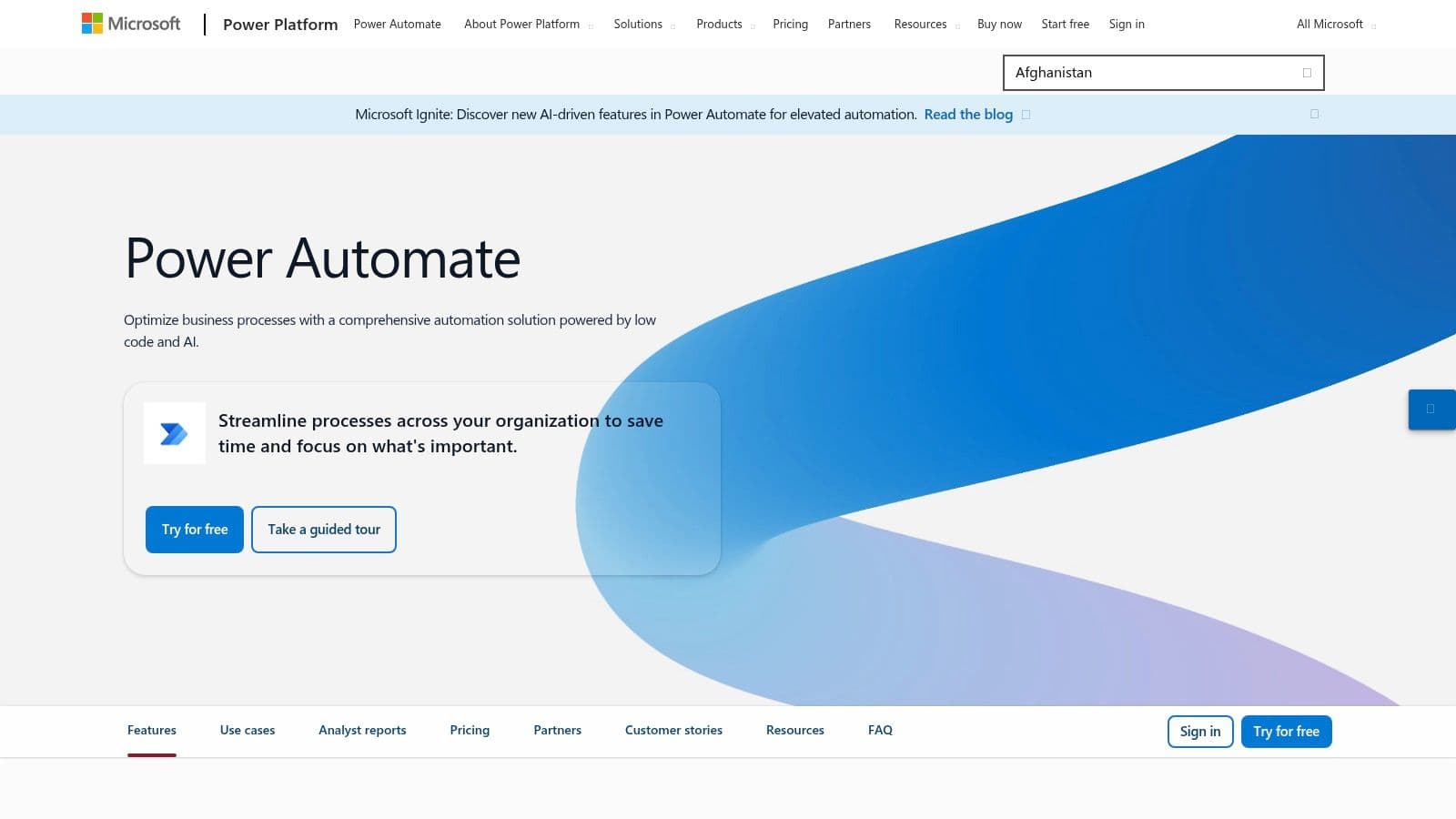
Why Microsoft Power Automate Stands Out
Power Automate's key differentiator is its seamless fusion of modern API-based automation with powerful RPA capabilities. Users can build "desktop flows" to mimic human actions like clicks and keyboard entries in older systems without APIs, bridging the gap between legacy and cloud. A practical tip for daily productivity is to use the AI Builder to process incoming emails. For instance, you can build a flow that extracts key text from customer invoices received in Outlook, uses AI to identify the amount and due date, and then automatically populates a row in an Excel Online spreadsheet for tracking. This provides a direct, meaningful benefit by automating tedious data entry. For those looking to optimize their digital routines, exploring various productivity apps for your Mac can further enhance these automated workflows.
Pricing, Pros & Cons
| Aspect | Details |
|---|---|
| Pricing | Included in many Microsoft 365/Dynamics 365 licenses. Premium plans start at $15 per user/month. Pay-as-you-go and per-bot plans are available for RPA. |
| Pros | Deep Microsoft Integration: Unparalleled connectivity with Office 365, SharePoint, Teams, and Azure. Hybrid Automation: Combines API connectors and desktop RPA in one platform. Enterprise-Ready: Strong governance, security, and administration controls. |
| Cons | Licensing Complexity: Costs can rise quickly with premium connectors and RPA add-ons. Ecosystem-Dependent: The best value is overwhelmingly for organizations already invested in Microsoft's ecosystem. |
Website: microsoft.com/en/power-platform/products/power-automate
6. Workato
If you're looking for an enterprise-grade solution that goes beyond simple app connections, Workato is a powerhouse. It's an Integration Platform as a Service (iPaaS) built for complex, cross-departmental automation that requires robust security, governance, and scalability. While simpler tools connect apps, Workato orchestrates entire business processes, from employee onboarding to financial reconciliation, making it one of the best workflow automation software choices for large organizations where IT oversight is critical.
Workato is designed around "recipes," which are its version of automated workflows. These can handle everything from simple data syncs to sophisticated, multi-step processes involving API management, data transformation, and conditional logic. It's the kind of platform that IT and business teams can collaborate on to build and manage mission-critical automations.
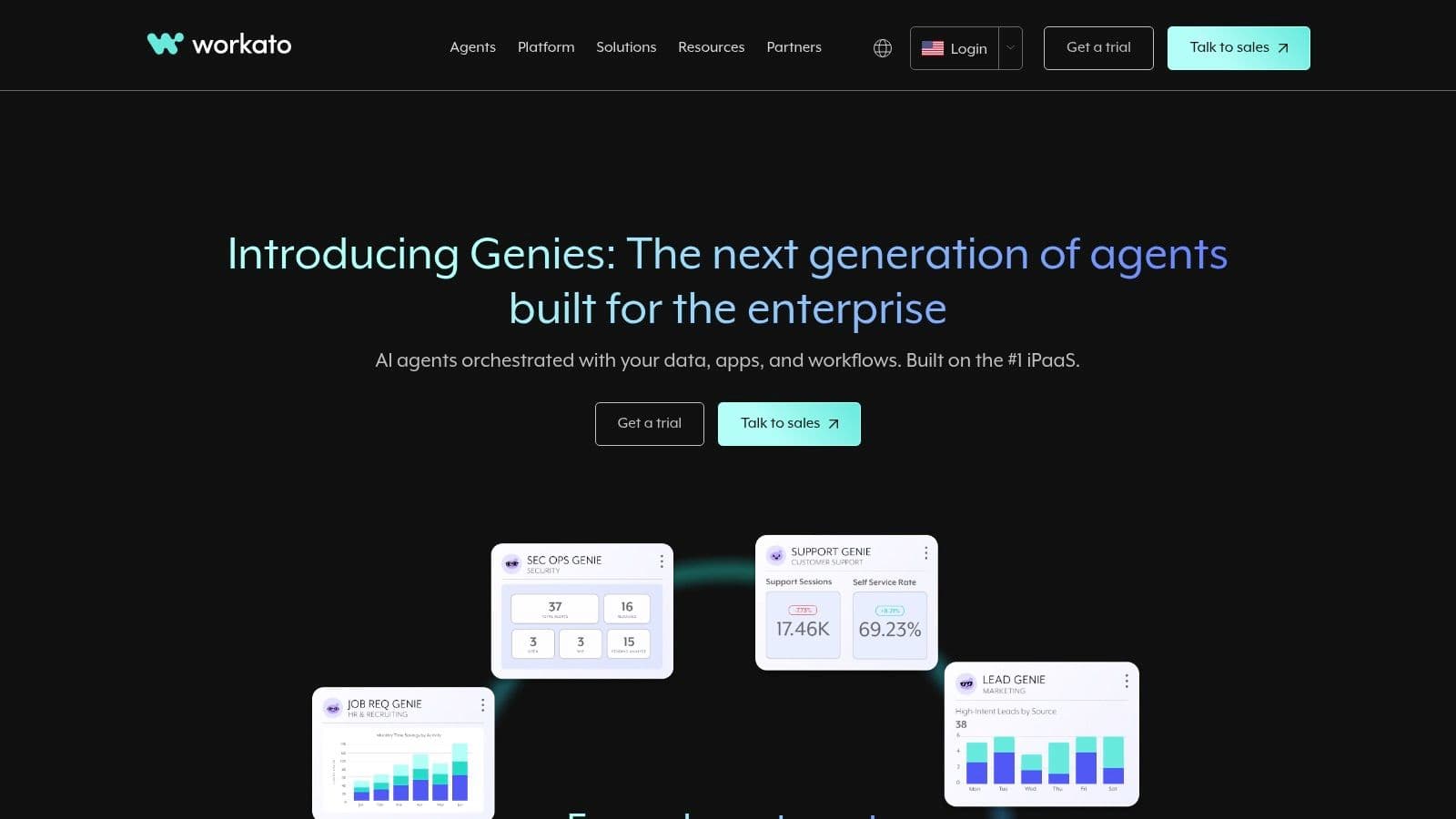
Why Workato Stands Out
Workato's strength lies in its enterprise-first approach. It provides a single platform for both integration and automation, complete with advanced features like API management, strong development and operations tooling, and embedded iPaaS support. This means you can not only connect cloud apps but also manage on-premise systems, databases, and custom APIs. To gain meaningful AI benefits, teams can use its AI capabilities to analyze unstructured text data. For example, a recipe could monitor support tickets, use AI to classify the text by urgency and topic, and then automatically route it to the correct engineering or support queue, speeding up resolution times. This helps automate repetitive tasks at a massive scale while maintaining strict control and visibility.
Pricing, Pros & Cons
| Aspect | Details |
|---|---|
| Pricing | Based on usage, with multiple platform editions. There is no public per-seat pricing; you must contact sales for a custom quote. A "High-Volume Recipe" (HVR) model offers predictable costs for heavy flows. |
| Pros | Enterprise-Grade: Superior security, governance, and compliance features. Highly Scalable: Built to handle mission-critical processes and high volumes of data for large organizations. Flexible and Powerful: Advanced connectors, API management, and both cloud and on-premise integration capabilities. |
| Cons | High Cost: Typically has a higher total cost of ownership compared to SMB-focused tools. Steeper Learning Curve: Requires more technical expertise to fully leverage its capabilities, making it less ideal for non-technical users. |
Website: workato.com
7. Tray
Tray.io is a low-code automation platform that bridges the gap between user-friendly tools and powerful enterprise-grade solutions. It’s designed for organizations that need more control, security, and scalability than simpler tools offer but still want the accessibility of a visual workflow builder. Tray excels at handling complex, multi-step processes across marketing, sales, and support departments, making it one of the best workflow automation software choices for scaling businesses.
The platform empowers teams to build robust integrations with a drag-and-drop interface, but its real power lies in its depth. You can manage logic, transform data, and orchestrate sophisticated workflows that automate entire business functions, not just simple tasks. It’s the kind of tool that can start by automating departmental reporting and grow to handle customer data synchronization across your entire tech stack.
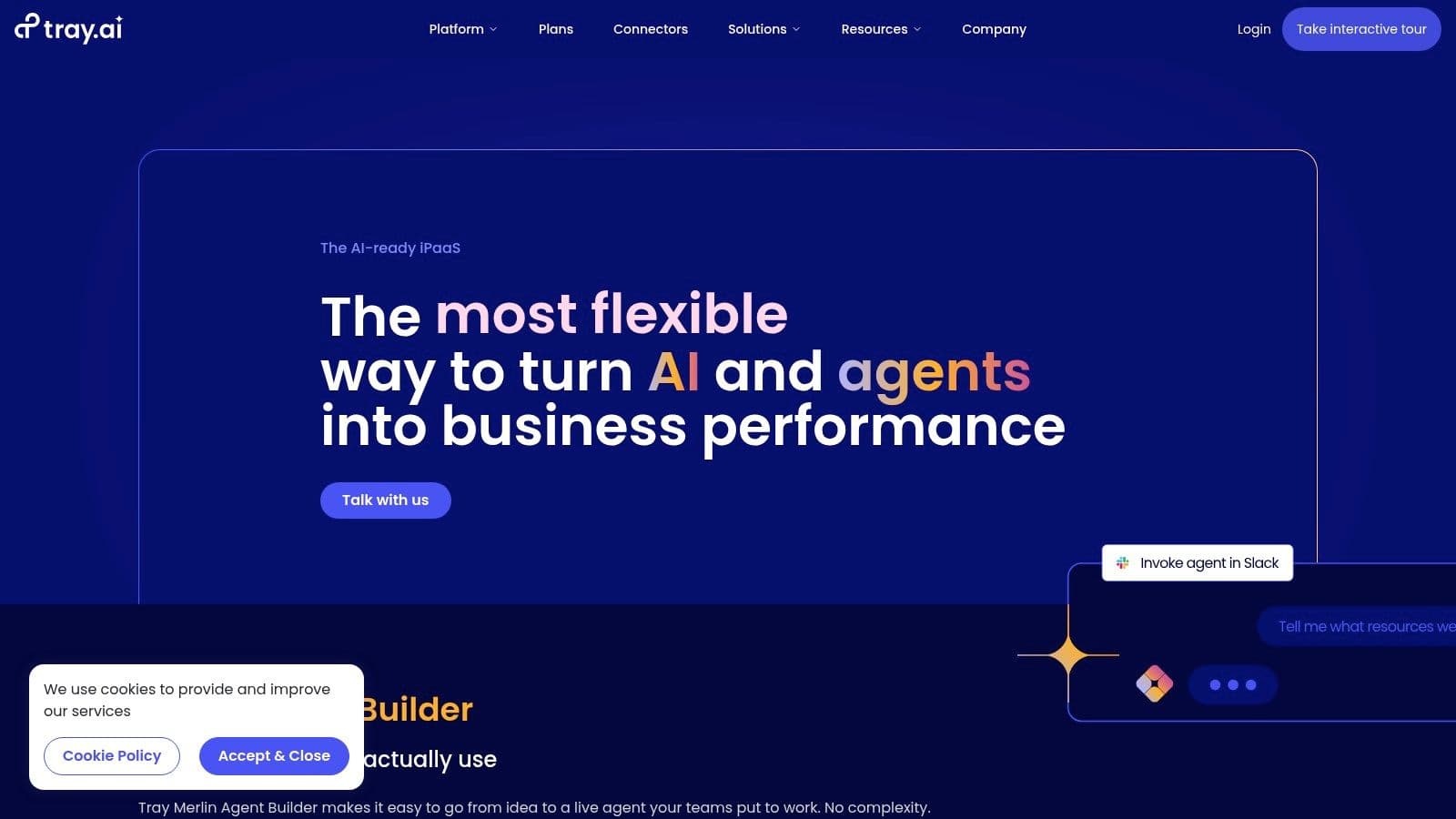
Why Tray Stands Out
Tray's key differentiator is its enterprise-ready architecture combined with a low-code approach. Its multi-workspace management allows different teams to build and manage their own automations securely, while composable templates accelerate adoption across the organization. For a practical productivity tip, users can integrate Tray with AI services to enrich data. For example, a sales team could build a workflow that takes new lead information, sends the company name to an AI-powered data enrichment tool to find industry and size, and then updates the CRM record with that text-based context, helping reps prioritize outreach more effectively.
Pricing, Pros & Cons
| Aspect | Details |
|---|---|
| Pricing | Custom pricing based on usage and features. You'll need to contact sales for a quote, which is typical for enterprise-focused platforms. |
| Pros | Enterprise-Grade: Suitable for departmental to company-wide rollouts with strong governance. Powerful & Flexible: Handles complex logic and data transformations with ease. Embedded iPaaS: A unique offering for SaaS companies to provide native integrations to their users. |
| Cons | Complex Pricing: The task-based model and need to engage with sales can make cost prediction difficult. Steeper Learning Curve: More powerful than entry-level tools, which requires more upfront learning to master. |
Website: tray.io
8. IFTTT
IFTTT, which stands for "If This, Then That," is one of the original players in the no-code automation game and a fan favorite for personal productivity and smart home integrations. It operates on a simple but powerful principle of "Applets," which connect a trigger from one service to an action in another. For small businesses and solopreneurs, it offers an incredibly accessible entry point into the world of workflow automation.
Think of IFTTT as the perfect tool for automating your digital life and simple business tasks. You can create Applets like "If I post a new photo on Instagram, then save it to a Dropbox folder" or "If I get an email with 'invoice' in the subject, then log it in a Google Sheet." It’s designed to be dead simple, connecting services that might not otherwise interact, from your social media accounts to your smart lights. This makes it one of the best workflow automation software options for straightforward, set-and-forget tasks.
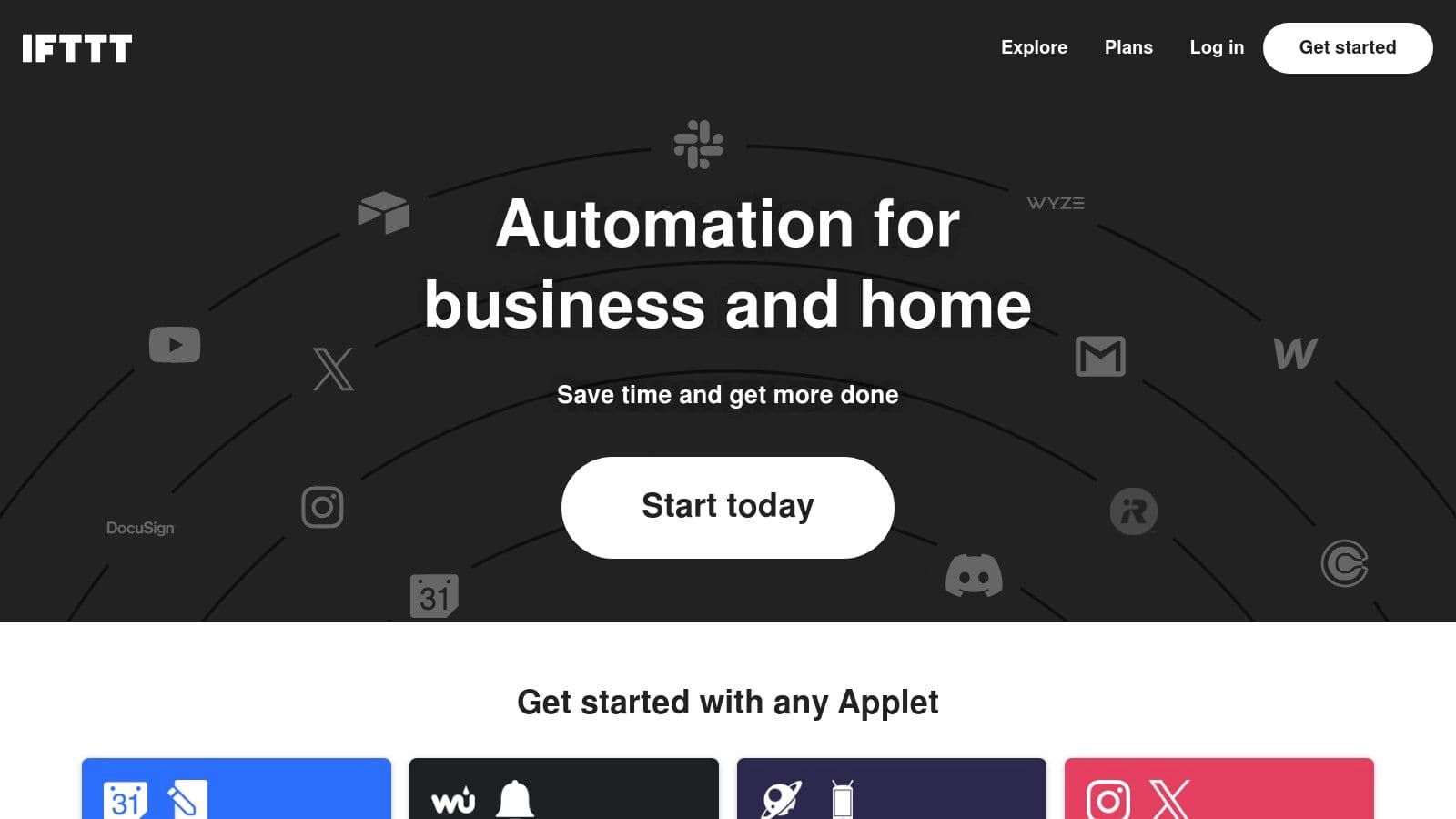
Why IFTTT Stands Out
IFTTT's primary strength is its simplicity and its deep integration with consumer apps and Internet of Things (IoT) devices. To boost your text-based productivity, you can use its AI services to create summaries. Set up an Applet that triggers when you save an article to Pocket, sends the article's text to an AI summarizer, and then emails you a concise, bullet-point summary. This is a simple, meaningful way to stay informed without reading every word, perfect for a busy daily life. The Pro+ plan unlocks more power, allowing for multi-action Applets and filter code for conditional logic.
Pricing, Pros & Cons
| Aspect | Details |
|---|---|
| Pricing | Includes a Free plan with 2 Applets. Paid plans (Pro and Pro+) start at $2.50/month and unlock more Applets, faster execution, and advanced features. |
| Pros | Extremely Easy to Use: The learning curve is practically non-existent. Affordable: Very budget-friendly for individuals and small businesses with light automation needs. Strong IoT & Consumer App Ecosystem: Unmatched for smart home and personal productivity automations. |
| Cons | Not for Complex Workflows: Lacks the advanced branching logic and error handling needed for mission-critical business processes. Limited Enterprise Features: Missing key administrative, security, and governance tools for larger teams. |
Website: ifttt.com
9. UiPath
For those who need to automate beyond simple app connections, UiPath emerges as a powerhouse in the world of Robotic Process Automation (RPA). This platform is built for complex, enterprise-level tasks where automation needs to interact with desktop applications, virtual machines, and legacy systems that don't have modern APIs. Think of it as a digital workforce that can mimic human actions on a computer, from clicking buttons and entering data to extracting information from documents.
UiPath allows you to design and deploy software "bots" that can handle repetitive, rule-based tasks with precision and speed. For instance, a bot can be trained to open an invoice from an email, extract key details like the vendor and amount, enter that data into an accounting system, and then archive the original email. It’s a true end-to-end solution for digitizing manual business processes.
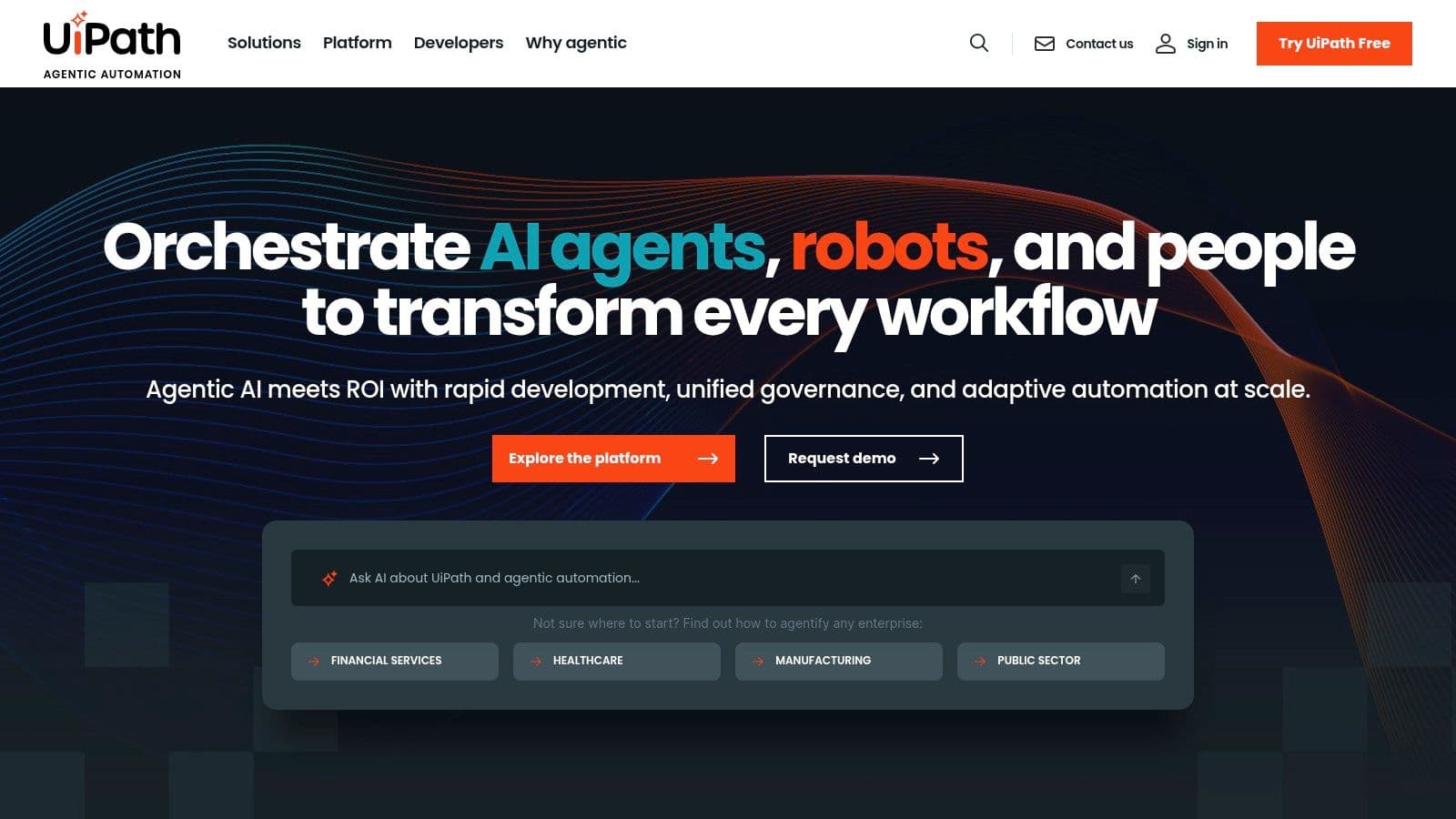
Why UiPath Stands Out
UiPath's strength lies in its comprehensive approach to automation. It's not just about connecting apps; it’s about discovering, building, managing, and running automations at scale. A practical way to use its text-based AI is with its Document Understanding feature. You can train a bot to read unstructured text from PDFs or scanned images—like contracts or resumes—extract specific information, and then structure it into a usable format in a database or CRM. This provides a massive productivity benefit by turning mountains of text into actionable data without manual effort.
Pricing, Pros & Cons
| Aspect | Details |
|---|---|
| Pricing | Offers a Free plan for individual use and a 60-day enterprise trial. Paid plans (Pro, Enterprise) are custom-quoted based on the number of bots and orchestration needs. |
| Pros | Comprehensive Platform: Covers everything from process discovery to bot orchestration and governance. Handles Complex Tasks: Excels at automating legacy systems and UI-based workflows where APIs aren't available. Highly Scalable: Built for enterprise security, compliance, and large-scale bot deployment. |
| Cons | Steep Learning Curve: More complex than no-code platforms and often requires developer or IT involvement. High Cost of Ownership: Enterprise pricing and implementation can be a significant investment. |
Website: uipath.com
10. Automation Anywhere
Diving into the enterprise end of the pool, Automation Anywhere is a formidable player in the Robotic Process Automation (RPA) space. This cloud-first platform is designed for large-scale operations that need to automate complex, repetitive tasks across legacy systems, modern apps, and virtual desktops. Think of it as deploying a digital workforce of "bots" that can mimic human actions like data entry, claims processing, or customer onboarding with precision and speed.
Its strength lies in providing a robust, secure, and scalable environment for both attended bots (which work alongside human employees) and unattended bots (which run scheduled tasks in the background). This makes it one of the best workflow automation software choices for regulated industries like finance and healthcare that demand high compliance and auditability.
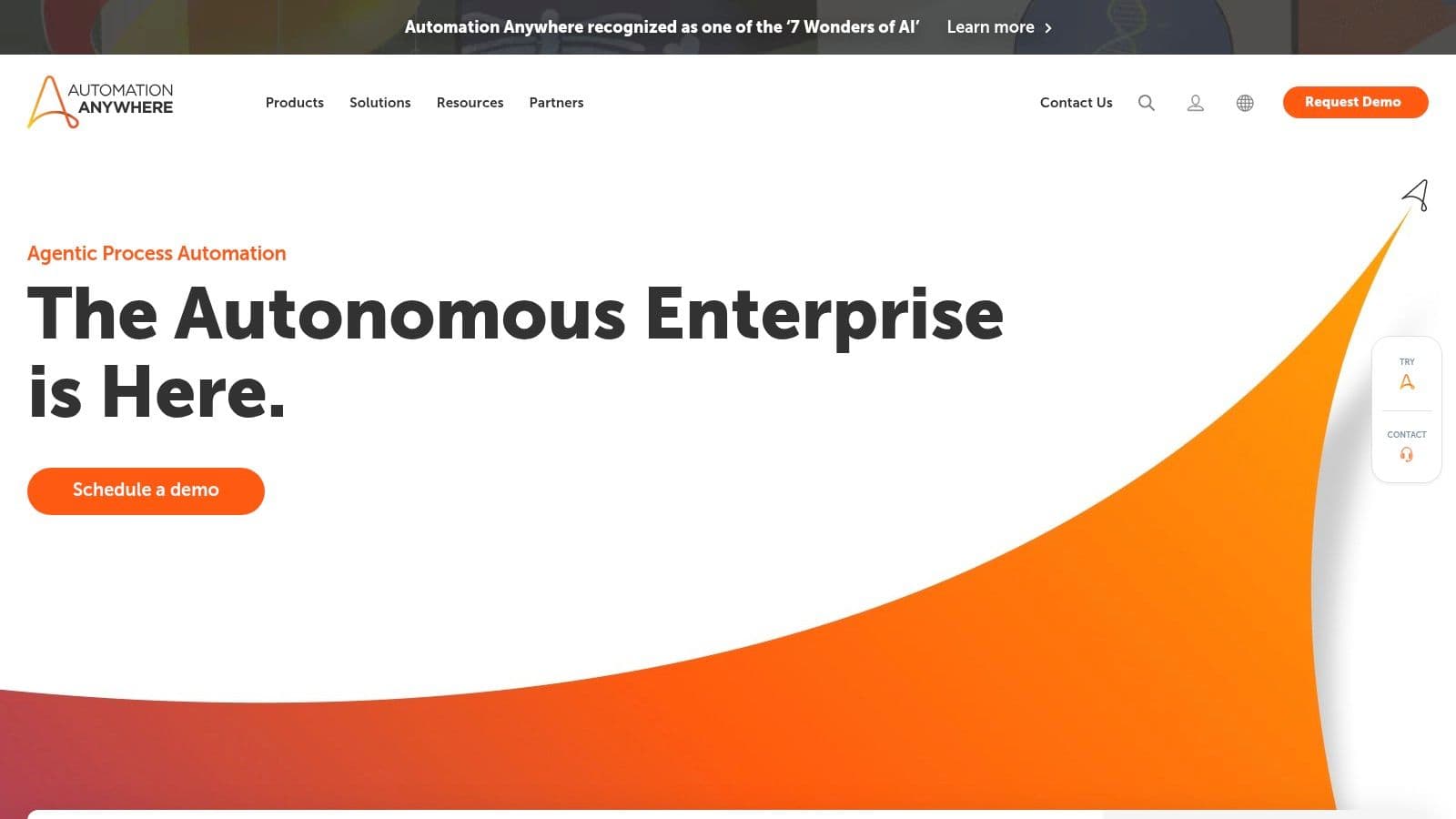
Why Automation Anywhere Stands Out
What truly sets Automation Anywhere apart are its industry-specific solution accelerators. To achieve meaningful productivity gains with text, users can leverage its built-in Document Automation AI to process complex documents. For example, a bot can extract data from various invoice formats, validate the text against business rules, and flag exceptions for human review. This text-centric automation drastically reduces manual data entry errors and accelerates payment cycles, delivering a clear ROI. The platform's cloud-native architecture also ensures you can manage your digital workforce and scale operations globally.
Pricing, Pros & Cons
| Aspect | Details |
|---|---|
| Pricing | Pricing is not publicly listed and requires contacting their sales team. A Free Community Edition is available for developers and small businesses to explore the platform. |
| Pros | Mature, Cloud-Delivered RPA: A powerful and scalable solution for enterprise-grade automation. Free Community Edition: A generous offering for individuals and small teams to learn and build bots. Industry Accelerators: Ready-made bots drastically shorten the time to value for specific business functions. |
| Cons | Complex Pricing: The bot-based licensing model can be difficult to forecast and requires a sales consultation. Steeper Learning Curve: More complex and feature-rich than no-code connectors, requiring more specialized skills to implement. |
Website: automationanywhere.com
11. G2
While not a workflow automation tool itself, G2 is an indispensable starting point for finding the right one. It's a massive peer-review marketplace where real users share their honest experiences with software, making it a critical research hub. Instead of relying on vendor marketing, you can compare the best workflow automation software based on unfiltered reviews, ratings, and detailed feature breakdowns from people who use these tools every day. It’s like having thousands of colleagues give you their recommendations.
Think of G2 as your strategic advisor. You can filter platforms by company size, industry, or specific features you need, like API access or no-code builders. The platform’s "Grid" reports visually map out market leaders versus high-performers based on user satisfaction and market presence, giving you a quick, data-driven snapshot of the competitive landscape.
Why G2 Stands Out
G2's superpower is authentic, crowd-sourced validation. Before you commit to a platform, you can dive into detailed reviews that cover what users love, what they dislike, and the specific business problems the software solved for them. A practical tip is to search for reviews mentioning "AI" or "text generation" to see how real users are getting productivity benefits from these features. This provides invaluable context that a feature list can’t, helping you validate a tool's pros and cons before investing your time and money.
Pricing, Pros & Cons
| Aspect | Details |
|---|---|
| Pricing | Completely Free to use for research and software comparison. Vendors pay for enhanced profiles and marketing features. |
| Pros | Authentic User Reviews: Get unbiased insights directly from real-world users. Powerful Comparison Tools: The Grid reports and detailed filters make it easy to shortlist options. Broad Coverage: Includes everything from niche tools to enterprise-level iPaaS solutions. |
| Cons | Category Overlap: Workflow tools are sometimes mixed with project management or communication software. Vague Enterprise Pricing: Pricing for larger solutions often isn't listed and requires contacting the vendor directly. |
Website: g2.com/categories/workflow-management
12. Capterra
While not a workflow automation tool itself, Capterra is an essential first stop for anyone trying to find the right software for their needs. It’s a massive software directory where you can compare hundreds of options side-by-side. Think of it as a strategic map for navigating the complex landscape of the best workflow automation software, helping you shortlist candidates before you commit to demos and trials.
Instead of building workflows, you use Capterra to understand them. The platform provides detailed buyer's guides, user reviews, and pricing summaries that break down what each tool does best. For example, you can filter for workflow management software that offers a free trial, is cloud-based, and integrates with specific tools you already use. It’s an invaluable resource for making an informed purchasing decision without endless Google searches.
Why Capterra Stands Out
Capterra's strength lies in its comprehensive comparison features and user-generated reviews. You can select a few promising tools and view a head-to-head comparison of their features, pricing models, and target audience. For practical productivity benefits, read reviews to understand how others have successfully used text-based AI features within a tool. These real-world anecdotes offer powerful tips and inspiration for automating your own daily writing and data-entry tasks, giving you a clearer picture than marketing materials alone ever could.
Pricing, Pros & Cons
| Aspect | Details |
|---|---|
| Pricing | Free to use for buyers. Capterra makes money from software vendors who pay for placement and lead generation. |
| Pros | Clear Categorization: Easily filter and find tools based on specific business needs and features. SMB-Friendly: Excellent visibility into options with transparent pricing for small and medium-sized businesses. Comprehensive Info: Access pricing, features, and user reviews all in one place. |
| Cons | Sponsored Placements: Featured listings are paid, so it's wise to cross-reference with organic results. Broad Scope: Some listed tools may be more focused on project management than pure workflow automation. |
Website: capterra.com/workflow-management-software/
Top 12 Workflow Automation Software Comparison
| Product | Core Features / Capabilities | User Experience & Quality ★★★★☆ | Value & Pricing 💰 | Target Audience 👥 | Unique Selling Points ✨ |
|---|---|---|---|---|---|
| 🏆 TypeBoost | System-wide AI prompts, Text & Voice Modes | Keyboard-first UX, seamless in-place AI | Free plan; Starter €5/mo; Pro €12/mo | Creators, solopreneurs, professionals | Prompt library, global shortcuts, voice+text |
| Zapier | Visual multi-step automation, 6,000+ app integrations | Easy setup, wide app coverage | Task-based pricing, free trial | SMBs, teams needing quick automation | Huge app library, no-code Zaps |
| Make (Integromat) | Modular workflows, routers/filters, 2,000+ apps | Strong logic support, operation transparency | Operation-based pricing | Agencies, SMB teams, makers | Advanced scenario control, AI add-ons |
| n8n | Open-source, self-hosting, developer-friendly | Extensible, technical flexibility | Execution-based pricing, cost-efficient | Developers, tech-savvy users | Self-host option, JS code nodes |
| Microsoft Power Automate | Microsoft 365 integration, RPA + API flows | Deep MS ecosystem integration | Per-user and per-bot licensing | MS 365/Azure users, enterprises | RPA + API+ process mining in one platform |
| Workato | Enterprise iPaaS, API management, usage-based pricing | Enterprise-grade security | Higher cost, usage-based pricing | Large organizations, IT-led automation | Scalable, strong governance tools |
| Tray | AI-ready visual builder, multi-workspace support | Strong customer success | Sales-engaged pricing, task-based | Dept to enterprise scale teams | Embedded iPaaS, customer product integrations |
| IFTTT | Simple applets, 900+ services | Very easy for non-tech users | Affordable plans for light usage | Personal users, small biz | Consumer IoT & mobile app ecosystem |
| UiPath | RPA bots, process mining, cloud/on-prem options | Mature, comprehensive, scalable | Complex pricing, IT-heavy | Enterprises with RPA needs | End-to-end automation, marketplace + training |
| Automation Anywhere | Cloud-first RPA, industry-specific bots | Mature, cloud-delivered | Typically sales contact pricing | Large enterprises, industry verticals | Industry accelerators, free Community Edition |
| G2 | User reviews & ratings, product comparisons | Broad vendor coverage, trusted insights | Free access | Buyers researching workflow tools | Real user reviews, market insights |
| Capterra | Buyer guides, pricing summaries | Clear categorization, practical advice | Free usage | SMB buyers, general software shoppers | Curated shortlists, pricing transparency |
The Takeaway: Start Small, Automate Smartly
We’ve just journeyed through a landscape packed with some of the best workflow automation software available, from simple task connectors like IFTTT to enterprise-level giants like UiPath. It’s easy to feel a mix of excitement and overwhelm. You might be picturing a future where your business runs on autopilot, but you might also be wondering where on earth to begin. The most important takeaway is this: automation is not about "boiling the ocean." It's about finding one leaky faucet and fixing it.
The secret to successfully integrating automation is to start small and be incredibly specific. Forget overhauling your entire business process overnight. Instead, think about the one task you did today that felt repetitive, drained your energy, or pulled you out of your creative flow. Was it manually summarizing meeting notes? Was it drafting five versions of a social media post? Or was it spending 20 minutes trying to rephrase an email to sound more professional?
That single point of friction is your perfect starting point. The goal is incremental progress, not instantaneous perfection. By automating one small, annoying task, you reclaim minutes, which quickly add up to hours. More importantly, you preserve your most valuable resource: your mental energy.
Choosing Your First Automation Ally
So, how do you pick the right tool from this massive list? It all comes down to the scale and nature of your problem.
- For Text-Based Friction: If your daily grind involves writing emails, reports, social media posts, or any client-facing content, your biggest bottleneck is likely the text itself. This is where a tool like TypeBoost shines. It offers immediate, high-impact wins by integrating AI-powered writing assistance directly where you work, eliminating the need to build complex, multi-step workflows. For solopreneurs, creators, and freelancers, this is often the most direct path to boosting productivity.
- For Process-Oriented Tasks: If your friction points involve moving data between two or more separate apps (like creating a Trello card from a new Gmail message), a platform like Zapier or Make is your ideal entry point. Their user-friendly interfaces and vast libraries of pre-built integrations make them perfect for tackling these common process-oriented headaches without needing any code.
- For Complex, Scalable Systems: If you're running a larger operation with intricate, multi-layered processes that require conditional logic and database manipulation, then stepping up to a more robust platform like n8n or even Workato might be necessary. Just remember, don't buy an enterprise-grade solution to automate a personal to-do list. Match the tool to the task at hand.
Your Action Plan: One Task, One Tool, One Trial
The best way to truly understand the power of automation is to experience it yourself. Don't just read about it; do it. Your mission, should you choose to accept it, is simple.
- Identify One Repetitive Task: Think back on your day. What's one thing you did that made you sigh and think, "There has to be a better way"? Write it down.
- Find a Potential Solution: Scan back through our list. Which tool seems best equipped to handle that specific task?
- Start a Free Trial: Nearly every tool we've covered offers a free plan or a trial. Sign up and commit just 30 minutes to automating that one task.
By focusing on one small win, you build momentum and confidence. You'll start seeing opportunities for automation everywhere, transforming it from an intimidating concept into a practical, daily superpower. The journey to becoming an automation pro begins not with a giant leap, but with a single, smart step.
Ready to eliminate your biggest daily friction point: writing? If you're tired of switching apps to get AI assistance for your emails, documents, and social posts, TypeBoost integrates seamlessly into your existing workflow. Get started for free and see how much time you can save at TypeBoost.